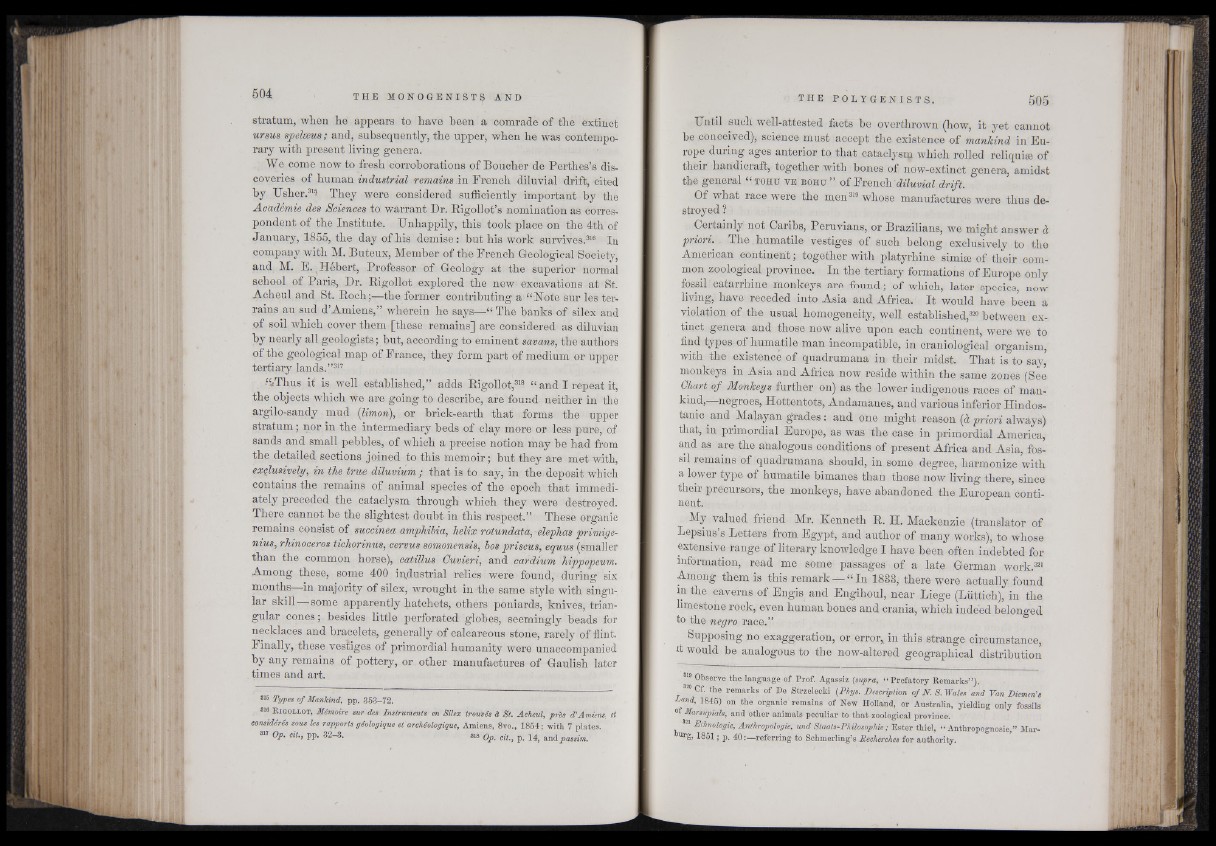
stratum, when he appears to have been a comrade of the extinct
ursus spelseus ; and, subsequently, the upper, when he was contemporary
with present living genera.
We come now to fresh corroborations of Boucher de Perthes’s discoveries
of human industrial remains in French diluvial drift, cited
by Usher.315 They were considered sufficiently important by the
Académie des Sciences to warrant Dr. Rigollot’s nomination as correspondent
of the Institute. Unhappily, this took place on the 4th of
January, 1855, the day of his demise: but his work survives.316 In
company with M. Buteux, Member of the French Geological Society,
and M. E. ^Hébert, Professor of Geology at the superior normal
school of Paris, Dr. Rigollot explored the new excavations at St.
Acheul and St. Rochq^the former contributing a “Rote sur les terrains
au sud d’Amiens,” wherein he says—“ The banks of silex and
of soil which cover them [these remains] are considered as diluvian
by nearly all geologists ; but, according to eminent savans, the authors
of the geological map of France, they form part of medium or upper
tertiary lands.”317
-“.«Thus it is well established,” adds Rigollot,318 “ and I repeat it,
the objects which we are going to describe, are found neither in the
argilo-sandy mud (limon), or brick-earth that forms the upper
stratum ; nor in the intermediary beds of clay more or less pure, of
sands and small pebbles, of which a precise notion may be had from
the detailed sections joined to this memoir; but they are met with,
exclusively, in the true diluvium ; that is to say, in the deposit which
contains the remains of animal species of the epoch that immedi-
ately preceded the cataclysm through which they were destroyed.
There cannot be the slightest doubt in this respect.” These organic
remains consist of succinea amphibia, helix rotundata,-elephas primige-
nius, rhinoceros tichorinus, cervus somonensis, bos priscus, equus (smaller
than the common horse), catillus Ouvieri, and cardium hippopeum.
Among these, some 400 industrial relics were found, during six
months in majority of silex, wrought in the same style with singular
skill—some apparently hatchets, others poniards, knives, triangular
cones ; besides little perforated globes, seemingly beads for
necklaces and bracelets, generally of calcareous stone, rarely of flint.
Finally, these vestiges of primordial humanity were unaccompanied
by any remains of pottery, or other manufactures of Gaulish later
times and art.
815 Types of Mankind, pp. 353-72.
818 R i q o l l o t , Mémoire sur des Instruments en Silex trouvés à St. Acheul, près d’Amiens et
considérés sous les rapports géologique et archéologique, Amiens, 8 yo., 1854 ; w i th 7 p l a t e s .
™ °P- ,iL> PP- 32-8- 818 Op. cit., p. 14, andpassim.
Dntil such well-attested facts be overthrown (how, it yet cannot
be conceived); science must accept the existence of mankind in Europe
during ages anterior to that cataclysm which rolled reliquiae of
their handicraft, together with bones of now-extinct genera, amidst
the general “tohu ve böhu ” of French diluvial drift.
Of what race were the men319 whose manufactures were thus destroyed?.;!
Certainly not Caribs, Peruvians, or Brazilians, we might answer ä
priori. . The.humatile vestiges of such belong exclusively to the
American continent; together with platyrhine simise of their common
zoological province. In the tertiary formations of Europe only
fossil catarrhine monkeys are found ; of which, later species, now
living, have receded into Asia and Africa. It would have been a
violation of the usual homogeneity, well established,320 between extinct
genera and those now alive upon each continent, were we to
find typesrof humatile man incompatible, in craniological organism,
with the existence of quadrumana in their midst. That is to say’
monkeys in Asia and Africa now reside within the same zones (See
Chart of Monkeys further on) as the lower indigenous races of mankind,
negroes, Hottentots, Andamanes, and various inferior Hindos-
tanic and Malayan grades: and one might reason (a priori always)
that, m primordial Europe, as was the ease in primordial America,
and as are the analogous conditions of present Africa and Asia, fossil
remains of quadrumana should, in some degree, harmonize with
a lower type of humatile bimanes than those now living there, since
their precursors, the monkeys, have abandoned the European continent.
My valued friend Mr. Kenneth R. H. Mackenzie (translator of
Lepsius’s Letters from Egypt, and author of many works), to whose
extensive range of literary knowledge I have been often indebted for
information, read me some passages of a late German work.32'
Among them is this remark —“ In 1883, there were actually found
in the caverns of Engis and Engihoul, near Liege (Lüttich), in the
limestone rock, even human bones and crania, which indeed belonged
to the negro race.”
Supposing no exaggeration, or error,, in this strange circumstance,
it would be analogous to the now-altered geographical distribution
819 Observe the language of Prof. Agassiz (supra, “ Prefatory Remarks”).
820 Of. the remarks of De Strzelecki (Phys. Description of N. S. Wales and Van Diemen’s
land, 1845) on the organic remains of New Holland, or Australia, yielding only fossils
of Marsupials, and other animals peculiar to that zoological province.
21 Ethnologie, Anthropologie, und Staats-Philosophie; Ester thiel, “ Anthropognosie,” Mar-
& 1851; p. 40:—referring to Schmerling’s Recherches for authority.